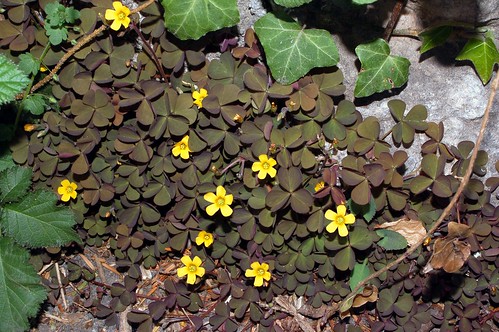
TheGardenLady received this question from Gay.
What do you recommend to eradicate Oxalis in coastal climate (SF Bay area)? This is not the ornamental type, it is invasive with a succulent flower stem and yellow blossom.
Oxalis – Oxalis corniculata L. , yellow wood sorrel is an invasive plant in California.
This GardenLady always tries to first recommend the safest method of weed removal, which is hand pulling. If you aren’t overwhelmed with too many Oxalis on your property always try hand pulling first. Now the problem with oxalis is that it has a long tap root. Besides these tap roots it also sends out stolons. A stolon is a shoot that bends to the ground or that grows horizontally above the ground and produces roots and shoots at the nodes. And it has rhizomes. A rhizome is a horizontal, usually underground stem that often sends out roots and shoots from its nodes. Plus Oxalis makes seeds. How is that for insuring species survival? So to eradicate the oxalis with all its alternative methods of growing into another plant, one has to get rid of all of its roots, stolons and rhizomes before it sets seed. That is very difficult to do. But one can try. If your soil is not rocky you can use a manual asparagus picker to get to the bottom of the tape root. I hope you can still purchase these manual asparagus pickers. They have a handle and sort of look like a long screw driver with a V at the end which is what you use to cut. However,TheGardenLady does not know where to buy them. Mine is an antique from my parents’ farm.
After you hand pull the oxalis, do NOT compost it! Since this weed is so invasive you don’t want it to have any chance to live. Put the entire weed in a plastic bag- black is best – and tie it up. Leave the bag with the weeds to bake in the sun for about 6 weeks. You want to kill every bit of that plant. The plastic bag lying in the sun will be like an oven. Then after you are sure that it is baked, throw the entire bag into your trash to be taken to the dump.
Now for the chemical treatment. Depending where the oxalis is located
you can use Scott’s Round-up or if the oxalis are in the lawn, you should use Ortho’s Weed be Gone. Round-up and Weed be Gone are supposed to be the safest weed killers out there. You spray Round-up on the weeds and the poison systemically goes to the tip of the roots. This takes a few weeks to happen which may allow enough time for the oxalis to set seed and form more babies that way, so you will have to keep spraying until everything is gone. Always follow the direcetions on the container of any chemical that you use in your garden. Scott’s give helpful expert advice at 888 270 3714. Since Ortho products are made by the Scott company, you can call the same number with your questions.
Please let TheGardenLady know if you have had any success.

Will Round Up or Weed-Be-Gone kill my St. Augustine grass? The oxilis is mixed in with the St. Augustine. Thanks.
This article does not do justice to the invasive and aggressive nature of Oxalis.
If you try this what is described above you will FAIL (guaranteed).
Hi Garden Lady: I am a Pest Control Advisor, or “PCA”, and I teach turf management at both Merritt College and Santa Rosa JC. I was educated at Cal Poly-SLO and will be publishing a “Guide to weed ID & control in lawns” fairly soon.I will be using this as my senior research project to graduate from Call Poly. Oxalis is one of those tough weeds to control. You are correct about the tap root and stolons!
My only advice is to use Turflon if oxalis is a problem in turf. Turflon is labelled specifically for oxalis and will eliminate it in 1-2 sprayings at 1 oz./gallon water. Just don’t spray above 80-85 degreesF. It may volatize and move toward other broadleaf weeds and plants and cause damage.Thx
Thanks again. If you would like a Turflon label, I can gladly email you back.
Sincerely,
Pete
Hi G.L.
I have a method that may seem counterintuitive but has worked in my yard. It does require patience. It took me three years.
1st line of defense: pull them. Using a garden fork penetrate the soil around the plants as deeply as possible gently loosening the soil as you go. The goal is to pull the rhizomes while still attached to the tap root. Don’t yank. Take your time and use a gentle lifting pressure. If the soil is sufficiently loosened you will be treated to the entire plant: tops, long white tap root, and a collection of rhizomes still attached to the bottom. Some will break off but they are usually the small ones that don’t have a lot of nutrition stored in them. They’ll make easier targets when they sprout again.
Second. Remember that they’re cool weather. In San Jose our afternoons can get very hot. Shade the soil around the plants to keep their “feet” cool, water them well, then fertilize them heavily (this is the HUH? part). This causes them to metabolize at a very high rate and makes them much more susceptible to systemics like Round Up. They’ll pull the glyphosphate in so quickly you might even begin to see same day signs of yellowing.
Repeat. Each rhizome is a storehouse of energy for the next plant. By keeping at them and depriving them of nutrition each subsequent sprout will be weaker and more readily attacked.
Depending on how severe the infestation it might take 3 years until they’re gone.
Now if I could just get my neighbors to get with the program ;D
Where can I purchase turflon